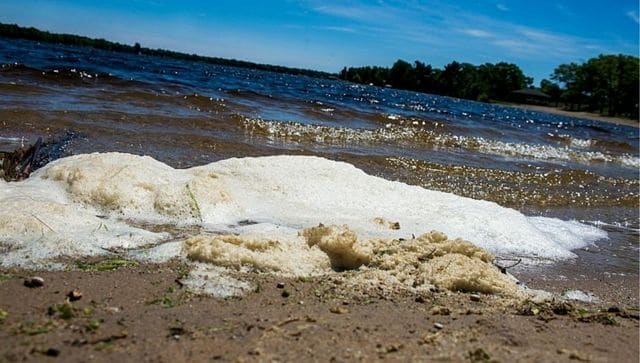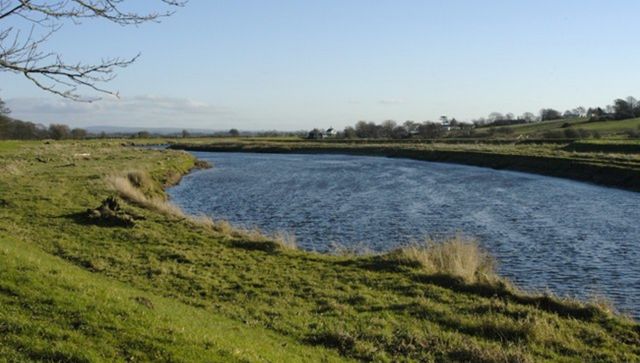“Forever chemicals” that do not break down in the environment and are likely toxic have been found in thousands of sites across the United Kingdom and Europe. As per The Guardian report, a major mapping project has discovered that per- and polyfluoroalkyl substances (PFAS) were present at high levels of over 1,000 nanograms a litre of water at around 640 sites, and above 10,000ng/l at 300 locations. PFAS is an umbrella term for 10,000 chemicals known for their non-stick and detergent properties. What are these forever chemicals and what has the mapping revealed about their spread in the UK and Europe? What danger do they possess? Let’s take a closer look. What are forever chemicals? PFAS have earned the moniker of ‘
forever chemicals
’ as they do not break down over time and can stay in the air, soil, water, and body for a long time. As per reports, they have been widely used since the 1940s in industrial manufacturing and can be found in a number of consumer products such as furniture, cookware, electronics, food packaging, waterproof clothing and firefighting foams. [caption id=“attachment_12199532” align=“alignnone” width=“640”] PFAS are used to make non-stick cookware. Pixabay (Representational Image)[/caption] They can easily wander into the environment and the global spread of only four PFAS in the atmosphere has caused “planetary boundary for chemical pollution being exceeded, raising risks to the stability of the Earth system”, The Guardian reported citing a group of scientists.
PFAS are used to make non-stick cookware. Pixabay (Representational Image)[/caption] They can easily wander into the environment and the global spread of only four PFAS in the atmosphere has caused “planetary boundary for chemical pollution being exceeded, raising risks to the stability of the Earth system”, The Guardian reported citing a group of scientists.
PFAS can also accumulate in humans and animals if they are continuously exposed to these human-made chemicals.
Perfluorooctanoic acid (PFOA) and perfluorooctane sulfonic acid (PFOS) are the most commonly studied PFAS, as per the US Agency for Toxic Substances and Disease Registry (ATSDR). ALSO READ: More than half of the cosmetics sold in US, Canada are full of toxins, says study How prominent are they in the US and Europe? As per the project, Belgium has the highest pollution levels, with PFAS contaminating groundwater at concentrations up to 73m ng/l around 3M’s PFAS manufacturing site in Zwijndrecht, Flanders, The Guardian reported. A high quantity of PFAS was discovered in the discharge from a chemicals plant on the River Wyre in Lancashire. As per The Guardian report, fish has been riddled with these forever chemicals, data from Defra’s Centre for Environment, Fisheries and Aquaculture Science says. In the Netherlands, an accident concerning PFAS in firefighting foam has polluted land around Schiphol airport in Amsterdam. This has led to the detection of high levels of PFOS in soils. Similar problems have been found at airports and military sites in Germany. PFAS have also made their way to drinking water sources in the UK. But companies have assured that these chemicals are not present in the final tap water. Professor Ian Cousins, an environmental scientist at Stockholm University, has warned about PFAS entering the groundwater. “PFAS in groundwater is a big problem because if that groundwater is abstracted for farming, or more importantly for humans as a water source, then you’ve got PFAS in your drinking water and it’s very difficult to remove”, Cousins told The Guardian. How dangerous are these forever chemicals? In humans, PFAS has been linked to thyroid disease, infertility, high cholesterol, and low birth weight, as per NBC News.
It can also increase the risk of certain cancers, such as that of the kidney and liver.
The US Centers for Disease Control and Prevention (CDC) says that people can be exposed to PFAS by drinking contaminated water, consuming food grown or caught near land or water where the chemicals are produced and even via direct contact. Direct exposure to PFAS occurs through cosmetics, sprays or dust from consumer products. Everyone has PFAS present in their blood at some level, noted The Guardian. [caption id=“attachment_12199552” align=“alignnone” width=“640”] Forever chemicals can pollute water, air and soil. AP File Photo[/caption] As per a study published on Wednesday (22 February) in Environmental Health Perspectives, forever chemicals disrupt several key biological processes, including the metabolism of fats and amino acids, in children and young adults, reported The Hill. Besides humans, PFAS also affects animals. A recent report by the nonprofit advocacy group – Environmental Working Group – revealed that over 330 species of wildlife around the world are contaminated with PFAS. It also detected 120 unique PFAS compounds in animals, including in some of the already threatened or endangered species, reported NBC News. Linda Birnbaum, toxicologist and former director of the US National Institute for Environmental Health Sciences, told The Guardian: “There’s an increasing amount of data showing PFAS are associated with a wide variety of health effects, not only in people but in animals. “I like to remind us all that we are a kind of animal … there are now hundreds of epidemiology studies showing associations with a wide variety of effects, including cancer, liver effects, kidney effects, effects on development and reproduction, growing evidence for effects on neurodevelopment, growing evidence for effects on type 2 diabetes … It’s kind of like the more you look, the more you begin to find associations with this very broad class of chemicals." Professor Crispin Halsall, an environmental chemist at Lancaster University, said PFAS “behave like surfactants, like soaps”. “They sit at the interfaces between water and particles, water and biota, they can transfer to the atmosphere and they’re so abundant they cycle around the wider environment, and that’s the problem we’ve got", Halsall was quoted as saying by The Guardian. With inputs from agencies Read all the
Latest News
,
Trending News
,
Cricket News
,
Bollywood News
, India News
and
Entertainment News
here. Follow us on
Facebook
,
Twitter
and
Instagram
.
Forever chemicals can pollute water, air and soil. AP File Photo[/caption] As per a study published on Wednesday (22 February) in Environmental Health Perspectives, forever chemicals disrupt several key biological processes, including the metabolism of fats and amino acids, in children and young adults, reported The Hill. Besides humans, PFAS also affects animals. A recent report by the nonprofit advocacy group – Environmental Working Group – revealed that over 330 species of wildlife around the world are contaminated with PFAS. It also detected 120 unique PFAS compounds in animals, including in some of the already threatened or endangered species, reported NBC News. Linda Birnbaum, toxicologist and former director of the US National Institute for Environmental Health Sciences, told The Guardian: “There’s an increasing amount of data showing PFAS are associated with a wide variety of health effects, not only in people but in animals. “I like to remind us all that we are a kind of animal … there are now hundreds of epidemiology studies showing associations with a wide variety of effects, including cancer, liver effects, kidney effects, effects on development and reproduction, growing evidence for effects on neurodevelopment, growing evidence for effects on type 2 diabetes … It’s kind of like the more you look, the more you begin to find associations with this very broad class of chemicals." Professor Crispin Halsall, an environmental chemist at Lancaster University, said PFAS “behave like surfactants, like soaps”. “They sit at the interfaces between water and particles, water and biota, they can transfer to the atmosphere and they’re so abundant they cycle around the wider environment, and that’s the problem we’ve got", Halsall was quoted as saying by The Guardian. With inputs from agencies Read all the
Latest News
,
Trending News
,
Cricket News
,
Bollywood News
, India News
and
Entertainment News
here. Follow us on
Facebook
,
Twitter
and
Instagram
.
)